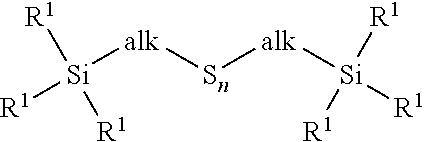Processes for making silane, hydrophobated silica, silica masterbatch and rubber products
a technology of hydrophobic silica and silane, which is applied in the directions of natural mineral layered products, cellulosic plastic layered products, transportation and packaging, etc., can solve the problems of reducing the efficiency of mixing operation, time-consuming and energy-intensive, and taking 10 minutes or longer, and achieves excellent scorch safety and no loss of silica
- Summary
- Abstract
- Description
- Claims
- Application Information
AI Technical Summary
Benefits of technology
Problems solved by technology
Method used
Image
Examples
example 1
Preparation of SMB with bis-(3-trimethoxysilylpropyl) disulfide (TMSPD)
[0116]A. Preparation of Compatibilized Silica Slurry
[0117]An aqueous solution of silane was prepared by charging to a vessel 4 grams of isopropanol, 2.36 grams of TMSPD, which was prepared using the procedure of U.S. Pat. No. 5,440,064 and which contains essentially no condensation products (6.0% by weight of the silica to be charged later), and 0.7 grams of acetic acid. The mixture was then stirred vigorously at room temperature while 96 grams of water was slowly added. The mixture was then stirred for a further 15 minutes until the solution cleared.
[0118]In a separate vessel equipped with a stirrer, 196 grams of silica cake (20% solids with the remainder being water) and 331 grams of water were charged. The mixture was then stirred for 15 minutes to ensure the cake was completely dispersed. Then the aqueous silane solution was added and stirred for a further 30 minutes. Using a 25% NaOH solution, the pH of the ...
example 2
Solubility of Silane Compounds
[0130]Silane coupling agents that are not sufficiently soluble in water do not effectively hydrophobate silica, in which case a great deal of silica is not incorporated into the masterbatch. If there is insufficient solubility, the composition of the silica-loaded rubber masterbatch does not meet tire manufacturing requirements, and silica is lost in the process, which increases raw material and waste disposal costs for the rubber plant. The following experiments were conducted to examine the solubility of various silane coupling agents.
TABLE 4Solubility of Silanes in water-isopropanol mixtures.SilanepH% Water (wt.)Soluble?TESPD3.822.2YesTESPD3.527.8NoTMSPD (Present invention)4.196.0YesMPTMS (A189)3.5-4.063.2YesMPTMS (A189)3.5-4.096.0YesMPTES3.5-4.063.2NoMPTMS—Mercaptopropyl trimethoxysilane
MPTES—Mercaptopropyltriethoxysilane
[0131]The data in Table 4 illustrate the solubility differences between methoxy and ethoxy silanes in alcohol / water solutions. Alt...
PUM
| Property | Measurement | Unit |
|---|---|---|
| wt % | aaaaa | aaaaa |
| weight | aaaaa | aaaaa |
| concentration | aaaaa | aaaaa |
Abstract
Description
Claims
Application Information
 Login to View More
Login to View More - R&D
- Intellectual Property
- Life Sciences
- Materials
- Tech Scout
- Unparalleled Data Quality
- Higher Quality Content
- 60% Fewer Hallucinations
Browse by: Latest US Patents, China's latest patents, Technical Efficacy Thesaurus, Application Domain, Technology Topic, Popular Technical Reports.
© 2025 PatSnap. All rights reserved.Legal|Privacy policy|Modern Slavery Act Transparency Statement|Sitemap|About US| Contact US: help@patsnap.com

